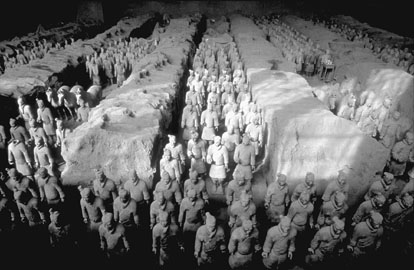

 | Page 1267 |  |
had become clear that the terracotta warriors (and horses) were indeed part of a buried army related to the mausoleum of Qin Shi Huang.
Excavation at the site has continued ever since, with three major pits being opened, and further explorations in the area surrounding the great mausoleum have revealed new sites. Thus far, over 8,000 warriors and horses have been recovered, along with over 100 wooden war chariots. A major museum has been constructed at the site of Pit 2 displaying many of the weapons found with the warriors, and another housing the incomparable bronze chariot and horses has opened recently.

Part of a buried terracotta army related to the mausoleum of China’s first emperor, Qin Shi Huang
(Gamma)
References
Wu Xiaocong. 1998. The Subterranean Army of Emperor Qin Shi Hwang. Beijing: China Travel and Tourism Press.
(1898–1975)
One of the greatest scholars of the ancient maya civilization, J. Eric S. Thompson was born and educated in England. He fought in World War I, and in the early 1920s, he spent some time as a gaucho in Argentina.
In 1926, Thompson traveled to mexico to work at chichén itzá. From 1926 to 1935 he worked for the Chicago Natural History Museum, and in 1935 he joined the staff of the Carnegie Institution, where he spent the rest of his career. Thompson traveled widely in the Maya area and published works covering the archaeology, ethnography, history, mythology, and hieroglyphic writing of the Maya. He was a prolific scholar, writing over 200 books and articles that ranged over a wide array of subjects, from the uses of tobacco among the Maya to legends concerning the moon. Many of Thompson’s books were written for the general public, and, along with his great contemporary sylvanus morley, he was largely responsible for popularizing the temples and sites of the Maya area. He also published several major scholarly books, one of which, Maya Hieroglyphic Writing (1950), was for its time as complete a statement about Maya hieroglyphics and calendars as could be made.
Maya hieroglyphs were Thompson’s great love, and it is ironic that Thompson was wrong
 |  |